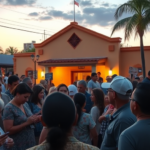Harlingen Man Charged After Crack Cocaine Found in Residence
In a significant narcotics investigation, authorities arrested Raul Flores, a Harlingen resident, following the discovery of substantial quantities of cocaine and crack cocaine in his home. This incident serves as a stark reminder of the persistent drug-related challenges facing the Rio Grande Valley (RGV) community.
Comprehensive Details of the Arrest
Raul Flores was taken into custody on Friday after a police raid uncovered over 80 grams of cocaine, 41.5 grams of crack cocaine, and a .45 caliber handgun at his residence on the 100 block of E. Cleveland Avenue. The Harlingen Police Department has charged Flores with the manufacture and delivery of a controlled substance, with a bond set at $50,000.
The Harlingen Police Department emphasized the significance of this operation, stating, “This operation underscores our ongoing commitment to disrupting drug-related activity and protecting our neighborhoods.” The department continues to urge community members to report any suspicious activities as part of their mission to promote public safety.
Background and Context
Drug-related issues have been a long-standing concern in South Texas, with the RGV being a critical area due to its proximity to the U.S.-Mexico border. The region is a key corridor for drug trafficking, which poses substantial challenges for law enforcement agencies striving to maintain community safety.
This recent arrest highlights the intensifying efforts by local authorities to address these issues head-on. Over the years, various initiatives and task forces have been deployed to combat drug abuse and trafficking in the area, showcasing the necessity for ongoing vigilance and cooperation among law enforcement entities.
Statements from Local Officials and Community Members
Harlingen Police Chief Michael Johnson commented on the case, expressing relief over the successful operation. “Any time we can take these substances off the street, it’s a win for our entire community. The safety and wellbeing of Valley residents remain our top priority, and we will continue to work tirelessly to ensure that drugs do not harm our neighborhoods,” he stated.
Local residents like Maria Rodriguez, a Harlingen community advocate, expressed concern about the continual drug issues but praised the police’s proactive measures. “It’s reassuring to know that our police department is actively working to keep our community safe. However, it’s also a call to action for more community engagement and education to tackle these issues from their roots,” Rodriguez noted.
Impact on the Rio Grande Valley
The arrest of Flores has a broader impact on the RGV, highlighting the recurrent struggle against drug trafficking and its implications for families and community safety. While law enforcement continues to make strides in curbing these challenges, the underlying socioeconomic factors contributing to drug trade activity need persistent attention from policymakers and community organizations.
The recent drug bust serves to remind Valley residents of the importance of community cooperation with law enforcement. It also stresses the need for programs aimed at reducing drug demand through education and support for those affected by addiction.
Connections to Previous Events
The flow of illicit drugs through the RGV is part of a larger narrative prevalent in border regions across the United States. Over the years, similar arrests have brought to light the intricate networks involved in drug distribution. These cases often illustrate the significant risks that law enforcement officials face daily to dismantle these networks.
Several community groups have consistently advocated for stronger policies to address these issues, promoting community resilience through education and prevention programs. Previous forums and outreach initiatives have sought to engage Valley residents and equip them with resources to combat drug dependence and its associated harms.
Potential Future Implications
Looking ahead, the arrest of individuals like Raul Flores could serve as a deterrent to others engaged in similar activities. Further law enforcement initiatives could potentially result from this case, focusing on dismantling larger networks operating within the region.
Policymakers might consider advancing collaborative approaches involving both preventive and punitive measures. By expanding access to education and health resources, communities can work to reduce susceptibility to drug abuse and encourage healthier lifestyles.
Local Resources for Residents
Valley residents seeking support or wishing to report suspicious activities can contact local law enforcement agencies or utilize community hotlines dedicated to tackling drug-related crimes. Additionally, several local organizations offer guidance and assistance for those dealing with substance abuse, including the RGV Council and Palmer Drug Abuse Program.
In conclusion, this case reflects the ongoing complexities surrounding drug challenges in the Valley. It aligns with a broader imperative for a united community focus on fostering safety, education, and alternatives to drug-related activities, essentially elevating the quality of life for all who call the RGV home.







